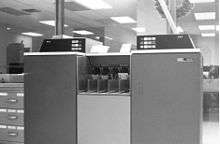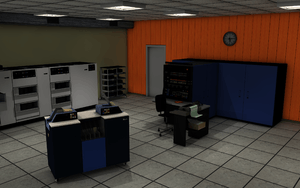IBM 2540
The IBM 2540 is a punched-card computer peripheral manufactured by IBM Corporation for use of System/360 and later computer systems. The 2540 was designed by IBM's Data Processing Division in Rochester, Minnesota, and was introduced in 1965.[1] The 2540 could read punched-cards at 1000 cards per minute (CPM) and punch at 300 CPM. The 2540 was based on the design of the older, slightly slower, 1402.

Description

The 2540 attached to a System/360 multiplexer or selector channel through an IBM 2821 Control Unit. A standard 2540 processed standard IBM 80 column punched cards. The card reader (2540R) and card punch (2540P) devices were separately addressable and functioned independently. The 2540 normally read and punched EBCDIC data, called data-mode 1.
Card reader
On the right side of the device was the reader, consisting of an input hopper holding approximately 3100 cards, and three output stackers (right to left – R1, R2, and RP3) each holding approximately 1350 cards. Cards could be directed to an output stacker under program control.
Card punch
On the left side of the device was the punch, with an input hopper holding about 1350 cards, and three output stackers (left to right – P1, P2, and RP3) each holding 1350. The center stacker (RP3) was shared between the reader and the punch, but was not intended to be used by both at the same time. Cards could be directed to an output stacker under program control. The card was read after punching to ensure that the data was punched correctly.
Special features
- Column binary – this feature, data-mode 2, allowed all possible combinations of holes to be read or punched in a column.
- Punch-feed-read – this feature allowed input cards to be read by the punch unit and data simultaneously punched into the same card. This feature was not normally supported by spooling software.
- 51-column Interchangeable Read Feed – this feature allowed the 2540 to read 51-column "stub" cards in addition to standard 80-column cards. Operator setup was required to change card size, so the two sizes could not be intermixed. Installation of this feature reduced the capacities of stackers R1 and R2 to around 800 cards, and reduced read speed to 800 CPM.[2]
Successors
With the introduction of System/370 IBM announced the improved 3525 card punch and the 3505 card reader in 1971.[3]
See also
References
- "IBM Rochester @ 50" (PDF). Charles Babbage Institute. Retrieved April 30, 2015.
- IBM Corporation (1965). IBM Systems Reference Library: IBM 2540 Component Description and Operating Procedures (PDF).
- "Rochester chronology". Retrieved April 30, 2015.